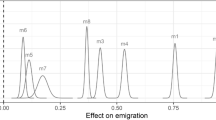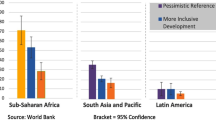Abstract
Human migration attributable to climate events has recently received significant attention from the academic and policy communities 1,2. Quantitative evidence on the relationship between individual, permanent migration and natural disasters is limited 3,4,5,6,7,8,9. A 21-year longitudinal survey conducted in rural Pakistan (1991–2012) provides a unique opportunity to understand the relationship between weather and long-term migration. We link individual-level information from this survey to satellite-derived measures of climate variability and control for potential confounders using a multivariate approach. We find that flooding—a climate shock associated with large relief efforts—has modest to insignificant impacts on migration. Heat stress, however—which has attracted relatively little relief—consistently increases the long-term migration of men, driven by a negative effect on farm and non-farm income. Addressing weather-related displacement will require policies that both enhance resilience to climate shocks and lower barriers to welfare-enhancing population movements.
This is a preview of subscription content, access via your institution
Access options
Subscription info for Japanese customers
We have a dedicated website for our Japanese customers. Please go to natureasia.com to subscribe to this journal.
Buy this article
- Purchase on SpringerLink
- Instant access to full article PDF
Prices may be subject to local taxes which are calculated during checkout

Similar content being viewed by others
References
Strömberg, D. Natural disasters, economic development, and humanitarian aid. J. Econ. Perspect. 21, 199–222 (2007).
Maystadt, J. & Mueller, V. Environmental migrants: A myth? IFPRI Research Brief 20 (2012).
Halliday, T. Migration, risk, and liquidity constraints in El Salvador. Econ. Dev. Cult. Change 54, 893–925 (2006).
Dillon, A., Mueller, V. & Salau, S. Migratory responses to agricultural risk in northern Nigeria. Am. J. Agric. Econ. 93, 1048–1061 (2011).
Gray, C. & Mueller, V. Drought and population mobility in rural Ethiopia. World Dev. 40, 134–145 (2012).
Gray, C. & Mueller, V. Natural disaster and population mobility in Bangladesh. Proc. Natl Acad. Sci. USA 109, 6000–6005 (2012).
Marchiori, L., Maystadt, J. & Schumacher, I. The impact of weather anomalies on migration in sub-Saharan Africa. J. Environ. Econ. Manage. 63, 355–374 (2012).
Gray, C. & Bilsborrow, R. Environmental influences on human migration in rural Ecuador. Demography 50, 1217–1241 (2013).
Feng, S., Krueger, A. & Oppenheimer, M. Linkages among climate change, crop yields and Mexico–US cross-border migration. Proc. Natl Acad. Sci. USA 107, 14257–14262 (2010).
International Federation of Red Cross and Red Crescent Societies (IFRC) World Disasters Report 2011: Focus on Hunger and Malnutrition (IFRC, 2011).
Walsh, D. Pakistan flood crisis as bad as African famines, UN says. The Guardian (27 January 2011); www.guardian.co.uk/world/2011/jan/27/pakistan-flood-crisis-african-famines (Accessed September 13, 2012).
Rasul, G. et al. Effect of temperature rise on crop growth & productivity. Pak. J. Meterol. 8, 53–62 (2011).
Bie Lilleør, H. & Van den Broeck, K. Economic drivers of migration and climate change in LDCs. Glob. Environ. Change 21, S70–S81 (2011).
Pakistan Panel Survey, 1986–1991 (International Food Policy Research Institute, 2000); http://www.ifpri.org/dataset/pakistan-panel-survey-1986-1991
Henry, S., Schoumaker, B. & Beauchemin, C. The impact of rainfall on the first out-migration: A multi-level event-history analysis in Burkina Faso. Popul. Environ. 25, 423–460 (2004).
Gray, C. Environment, land and rural out-migration in the southern Ecuadorian Andes. World Dev. 37, 457–468 (2009).
Massey, D., Axinn, W. & Ghimire, D. Environmental change and out-migration: Evidence from Nepal. Popul. Environ. 32, 109–136 (2010).
Gray, C. Soil quality and human migration in Kenya and Uganda. Glob. Environ. Change 21, 421–430 (2011).
Brakenridge, G. R. Global Active Archive of Large Flood Events (Dartmouth Flood Observatory, University of Colorado, 2012); http://floodobservatory.colorado.edu/Archives/index.html
Vicente-Serrano, S. M., Beguería, S. & López-Moreno, J. A multi-scalar drought index sensitive to global warming: The Standardized Precipitation Evapotranspiration Index—SPEI. J. Clim. 23, 1696–1718 (2010).
Rosenzweig, M. & Stark, O. Consumption smoothing, migration, and marriage: Evidence from Rural India. J. Pol. Econ. 97, 905–926 (1989).
McKenzie, D., Gibson, J. & Stillman, S. How important is selection? Experimental vs. non-experimental measures of the income gains from migration. J. Euro. Econ. Assoc. 8, 913–945 (2010).
Beegle, K., De Weerdt, J. & Dercon, S. Migration and economic mobility in Tanzania: Evidence from a tracking survey. Rev. Econ. Stat. 93, 1010–1033 (2011).
Fitzgerald, J., Gottschalk, P. & Moffit, R. An analysis of sample attrition in panel data. J. Hum. Resour. 33, 251–299 (1998).
Thomas, D. et al. Cutting the costs of attrition: Evidence from the Indonesia Family Life Survey. J. Dev. Econ. 98, 108–123 (2012).
Auffhammer, M., Hsiang, S. M., Schlenker, W. & Sobel, A. Using weather data and climate model output in economic analyses of climate change. Rev. Environ. Econ. Policy 7, 181–198
Acknowledgements
The authors are grateful for assistance and constructive comments from M. Auffhammer, M. Call, P. Dorosh, S. Hamza Haider, S. Hausladen, L. Hunter, J. Koo, H. L. Lee, S. Malik, J-F. Maystadt, H. Nazli, C. Ringler, W. Schlenker, E. Schmidt, T. Thomas, H. Tilahun, H. Xie, T. Zhu, and Innovative Development Strategies in this research. The participation of C.G. was supported by the National Institutes of Health (R00HD061752).
Author information
Authors and Affiliations
Contributions
V.M., C.G. and K.K. designed and performed the research, analysed the data, and wrote the paper.
Corresponding author
Ethics declarations
Competing interests
The authors declare no competing financial interests.
Supplementary information
Rights and permissions
About this article
Cite this article
Mueller, V., Gray, C. & Kosec, K. Heat stress increases long-term human migration in rural Pakistan. Nature Clim Change 4, 182–185 (2014). https://doi.org/10.1038/nclimate2103
Received:
Accepted:
Published:
Issue Date:
DOI: https://doi.org/10.1038/nclimate2103



